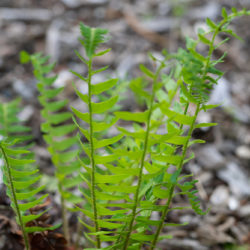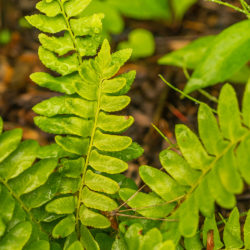Etymology
Polystichum is Greek from the words for many and in a row (in reference to spore cases being in rows); acrostichoides is Latin (from ancient Greek) meaning resembling a leather fern.
Native Habitat
Organically rich, acidic soils that are well-drained.
Garden Uses
This species will thrive in dryish or moist soils in woodland gardens, in shade gardens, shady areas of borders, and in wild or native plant gardens. May also be planted in shady areas along walls or foundations. A good plant for massing on slopes (including dryish, rocky ones) to help combat soil erosion. Evergreen fronds provide good winter interest for the landscape.
Overview
The Christmas fern is native to the Eastern United States and thrives in organically rich, acidic, dry to moist well-drained soils in part shade to full shade. It grows in a fountain-like clump to about 2’ tall. It has evergreen fronds, as the common name suggests). The stocking shape of the pinnae (primary division of a frond) also suggests Christmas. It is a clumping fern and will increase in size yet not spread or colonize the way some ferns do.
Leaves and Stems
Christmas ferns have leathery, lance-shaped fronds (the leaflike part of a fern) that are glossy when young. The crosiers (the curled top of a young fern called a fiddleheads) in spring are silvery and scaled.
Flowers
All ferns pre-date flowering plants; they reproduce by spores.
Fruit/Seed
Sori (a cluster of spore-producing receptacles on the underside of a fern frond) appear on the undersides of the pinnae (primary division of a frond) at the ends (last 1/3) of the fronds.
Animal Associates
Christmas ferns attract ruffed grouse, provide cover for wildlife, and are deer and rabbit resistant.
Propagation
Propagate by root division or by spores.
Ethnobotanical Uses
None found.
Garden Location
Entry Garden, Performance Hall Garden, Staff Entry Garden (see garden map)
Sources
Lady Bird Johnson Wildflower Center
Plant Profile by Kathy Kling



